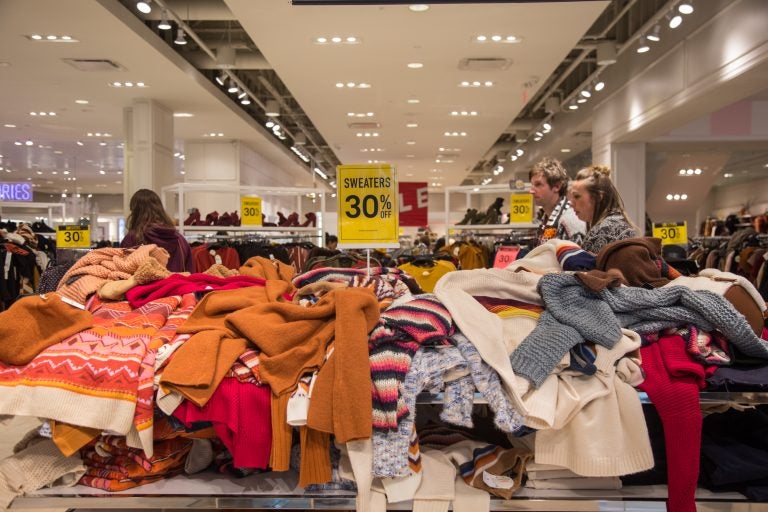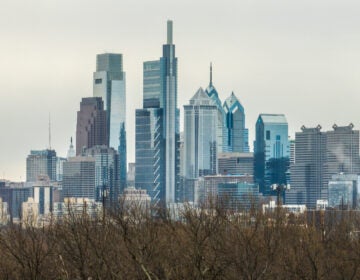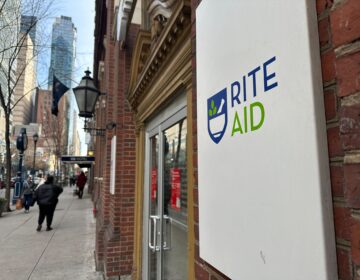The new Fashion District store may fit into Forever 21’s post-bankruptcy plan
Four stores in the region will close. One thing the retailer might have considered: the condition of some of its locations.

Sweaters are strewn about at Forever 21 on Black Friday at the King of Prussia Mall. (Emily Cohen for WHYY)
Forever 21 Inc. is slated to close up to 178 U.S. stores, part of its reorganization after filing for Chapter 11 bankruptcy over the weekend. Even as the “fast fashion” retailer announces which locations could shutter, a new Forever 21 is scheduled to open later this year at Fashion District Philadelphia.
This region will see an overall “trimming down” of the brand’s brick-and-mortar presence. On Tuesday, the company outlined plans to close at least four area stores: those at Cherry Hill Mall, Plymouth Meeting Mall, and Willow Grove Park, as well as a location on Chestnut Street in Philadelphia.
“They’ve opened way too many stores without really strategically thinking are they, in fact, cannibalizing the other stores that they already have open,” said Joseph Hancock, program director for Drexel University’s online Retail & Merchandising master’s degree program.
According to Forever 21’s store locator, the company had at least 10 stores within a 25-mile radius of Center City.
That’s just too many stores in close proximity to one another, Hancock said.
“We’ll start to see Forever 21 look at the more selective areas that are doing quite well and probably tailor the stores to that particular area,” he said.
One thing the company might have considered: the state of its individual locations. Stores require remodeling, and sometimes a facelift means serious investment.
“A lot of times, retailers will say, ‘You know what? We’re not going to remodel this store, we’re just going to close it down,’” Hancock said.
A more palatable decision? Opening a new location in a new mall, like Philadelphia’s Fashion District.
That space was still behind wooden construction panels, with a small sign reading, “Forever 21 Coming Soon.”
A public relations representative for PREIT, which owns the newly redesigned former Gallery on Market Street, said in an email Tuesday, “Fashion District currently has an executed lease with Forever 21, with an opening slated for later this year. There are no additional details to share at this time.”
The brand’s rise, and the need for adjustment
“Forever 21 was a really cool, modern concept at one time,” said Barbara Kahn, a marketing professor at the University of Pennsylvania’s Wharton School of Business.
But Kahn echoed Hancock’s analysis: Forever 21 “produced too many stores at exactly the wrong time.”
As online shopping took off, she said, Forever 21 doubled down on its brick-and-mortars because “fast fashion” was still doing well at the time. The chain displayed the newest designs on its store racks at a much faster rate than traditional retailers, which Kahn said could lag behind runway trends by as much as a year.
But retail trends are hard to predict. The tweens that helped bolster the brand in the 1990s are now adults in the workforce, likely to have different needs, Hancock said. And in the meantime, new purchase platforms for tweens and teens have emerged — Instagram and rental sites like Rent the Runway.
“All of this online shopping and price competition that Amazon and Walmart and Target are also putting in the mix — it makes it a difficult shopping environment,” Kahn said.
An already-struggling suburban mall would take another hit if it lost Forever 21, she said.
“And when that store is closing, and the anchors are closing, you can imagine the foot traffic to the mall will get lower and lower, so it’s kind of a downward spiral,” she added.
The process of ‘rightsizing’
When making closure decisions, industry observers say Forever 21 likely considered a number of variables, including the relationship between online and store performance in the markets it’s in.
“You may have a lot of customers [in the area], but if most of them are the type of customers who prefer to purchase online and they don’t like to visit stores, then it doesn’t make sense for that particular firm to maintain an offline store in the area,” said Subodha Kumar, a professor of marketing and supply chain management at Temple University’s Fox School of Business.
Proximity to competitors is a desirable trait the retailer might be looking to keep.
“The one thing that people always forget about with retailers — they like to cluster themselves in and around their competitors,” said Drexel’s Hancock.
If one retailer doesn’t meet a shopper’s needs, he said, the store next door wants to be visible when that shopper is looking for an alternative.
An opportunity to turn things around
In its Sunday bankruptcy filing, Forever 21 reported it had $1 billion to $10 billion in assets and liabilities.
Reuters reports existing lenders gave the company $275 million in financing to continue operations during the restructuring.
However, it’s the company that decides what to keep open and what to close, Kahn said. Forever 21 has an opportunity to be innovative like its competitors.
For example, Urban Outfitters recently partnered with Walgreens. Online shoppers can pick up their purchases at the local brick-and-mortar drugstore.
“There are a lot of things they can consider as the shopping environment is changing,” Kahn said, “and this is giving them the flexibility to test different ideas and find out which one works best for their customers.”
WHYY is your source for fact-based, in-depth journalism and information. As a nonprofit organization, we rely on financial support from readers like you. Please give today.





